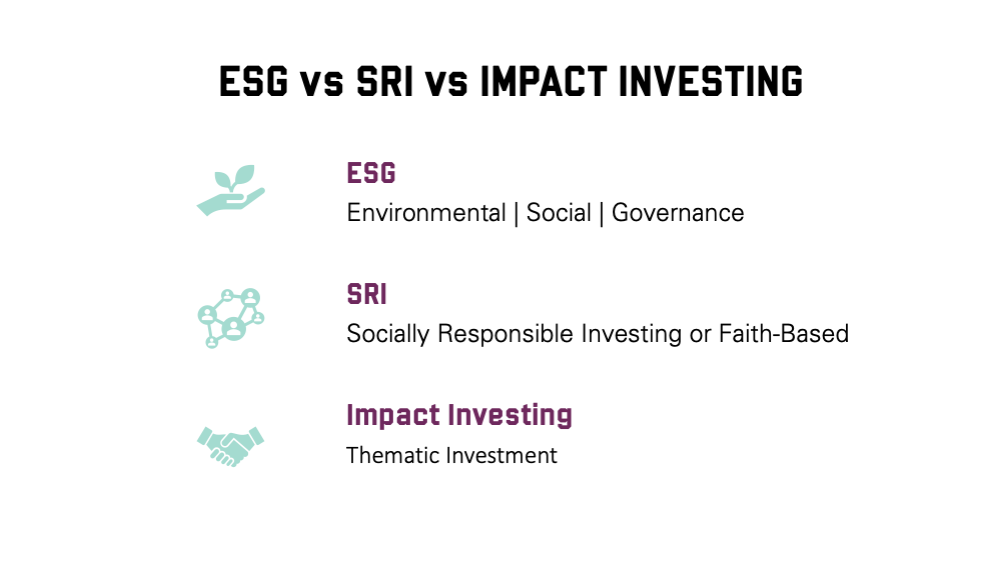INVESTMENT INSIGHTS PART I: What Is ESG Investing?
MODERNIST’S ASSET CLASS INVESTING PORTFOLIOS ARE STRATEGICALLY INVESTED WITH A FOCUS ON LONG-TERM PERFORMANCE OBJECTIVES. PORTFOLIO ALLOCATIONS AND INVESTMENTS ARE NOT ADJUSTED IN RESPONSE TO MARKET NEWS OR ECONOMIC EVENTS; HOWEVER, OUR INVESTMENT COMMITTEE EVALUATES AND REPORTS ON MARKET AND ECONOMIC CONDITIONS TO PROVIDE OUR INVESTORS WITH PERSPECTIVE AND TO PUT PORTFOLIO PERFORMANCE IN PROPER CONTEXT.
At Modernist we delight in helping our clients invest in movements and people that empower the world they envision. We aim to empower them to live their values by being awesome stewards of their resources, leveraging their financial structures (investments, banking, charitable, tax planning, etc.) to align with their vision for a better world.
We’re thrilled to see the growing interest in a more ethical and sustainable approach to investing. There are various motivations behind values-based investing which may earn three types of “returns”: financial, societal (improved outcomes for both people and the planet), and personal (emotional benefits).
The key takeaway is that values-driven investors should make sure the investment strategies they employ align with not only their financial objectives but also their societal goals and personal values.
The financial services industry has responded to demands for sustainable investment strategies with a dizzying array of product launches, however, fund companies are not using consistent terms to describe their products. Terms like ESG and SRI are used interchangeably, or the whole field is called “impact investing.” Other folks use terms such as “values-based,” “mission-driven,” “ethical,” “faith-based” or even just “responsible investing.” The lack of a common language makes it difficult for investors to understand what is available, what the intent or purpose of the investing style is, and what to expect about volatility or performance.
And this is where things might get confusing, as making values-based decisions requires context, which is not always the dominant way in the industry. We're here to help provide some clarity!
Let's start with the most common frameworks out there: ESG, SRI, and Impact Investing.
ESG is a criteria used to evaluate an individual investment vehicle. It concentrates on how the company approaches environmental issues (the E), their treatment of employees and stakeholders (the S, or "social"), and how they run the company from leadership standpoint (the G, or “governance”).
While the ESG framework scores companies against the above criteria, the purpose of the investment approach remains financial performance.
Next comes the "grandma" of values-based investing - Socially Responsible Investing or SRI. It all started in 1960s and 1970s, with roots in faith-based investing, the civil rights, anti-war, and environmental movements. SRI goes one step further than ESG by actively eliminating or selecting investments according to specific ethical guidelines, for example the investment in defense contractors during the Vietnam War.
Very often though, because the SRI screens are so specific to a movement or a religion, it could mean eliminating the companies that, for example, support women's agency over their own bodies. To that we say, thank you for starting the movement, SRI, but we at Modernist have moved on!
Lastly, with Impact Investing the positive outcomes are of the utmost importance — meaning the objective of impact investing is to help a business or organization accomplish specific goals that are beneficial to society or the environment. Investing in a company dedicated to the research and development of clean energy, regardless of whether success is guaranteed, is an example. With this approach, the returns are of the least significance. The impact reigns supreme and guides the investment decision.
We delight in working with clients on creating "satellite" portfolios for this purpose, specifically dedicated to community/small business support loans/giving, while the "main" portfolio is there to make sure that our clients’ fabulous 80-year-old selves are still supported.
In summary, there is a lot to consider when getting started with ethical investing. We recommend working with your advisor to get clear on your priorities and then implement a plan, and adjust as needed. It’s an exciting time and we’re glad to see such interest in a more sustainable future!


